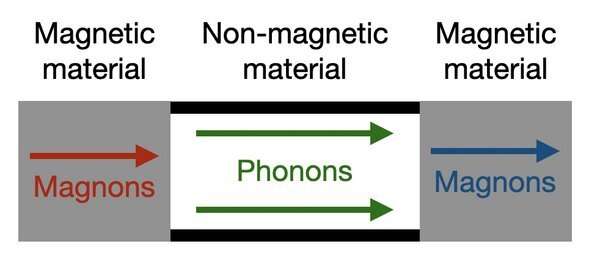Credit: Utrecht University
The flow of electric charge lies at the heart of electronic circuits. However, electrons also have spin, and flows of electron spin play a vital role in spintronic circuits. These could be essential for our future computing technologies. A current issue with traditional spintronic materials such as magnetic materials is that they are susceptible to electromagnetic fields, which could disrupt spin flows. Therefore, non-magnetic materials that are resistant to these fields are an attractive alternative. Rembert Duine of Eindhoven University of Technology and Utrecht University along with Andreas Rückriegel from Utrecht University have developed a new theory to study spin transport in non-magnetic materials. This theory can help in the design and development of new materials for future spintronic applications.
Since the 1990s, spintronics has been at the forefront of developments in technologies ranging from hard drives to smartphones. Electronic circuits use electron charge to process information where charge might represent as a one and the absence of charge represents a zero. Spintronic circuits use electron spin to carry information and spin can be either "up" or "down". In spintronics, these two spin states represent ones and zeros. These spins generate tiny magnetic fields and when exposed to a magnetic field, spins can be forced to align in one direction. The alignment of these spins in the material is assisted by spin waves, otherwise known as magnons.
Typically, spintronic circuits are based on magnetic insulators that do not conduct electric charge but can transport spin. However, electromagnetic fields can disrupt spin orientation and lead to instabilities. On the other hand, non-magnetic materials are not affected by electromagnetic fields, which means that they can reliably transfer spin information. Rather than magnons, spin information can be transmitted in non-magnetic materials using phonons, which are quasiparticles involved in the transmission of vibrational waves through materials. Rembert Duine, professor at the Department of Applied Physics (TU/e) and at Utrecht University, along with Andreas Rückriegel from Utrecht University have developed a new theory to study the propagation of spin via phonons through non-magnetic materials.
Credit: Eindhoven University of Technology
Model details
In their new model, Duine and Rückriegel sandwich a non-magnetic material between two magnetic materials. A spin current carried by magnons is generated in magnetic material to the left of the non-magnetic material. When the spin current reaches the interface, it interacts with the spins in the non-magnetic material leading to a phonon-regulated spin current through the non-magnetic material. When the phonon current reaches the second non-magnetic material/magnetic interface, the phonon spin current instigates a magnon current in the magnetic material on the right.
"The model shows that interactions between spins in the magnetic insulators and phonons in the non-magnetic material facilitates a spin current between the magnets that moves through the non-magnetic insulator separating the magnets", says Duine. Importantly, the resulting phonon spin current allows for spin transfer from one magnet to the other over distances at the millimeter scale. "Our model is just the first step. This needs to be verified experimentally, but this could have practical implications for electrically-driven spintronic devices in the future", adds Duine.
This work is published in Physical Review Letters (PRL) and featured in "Physics"—the online, free magazine from the American Physical Society.
More information: Andreas Rückriegel et al. Long-Range Phonon Spin Transport in Ferromagnet–Nonmagnetic Insulator Heterostructures, Physical Review Letters (2020). DOI: 10.1103/PhysRevLett.124.117201
Journal information: Physical Review Letters
Provided by Eindhoven University of Technology
























